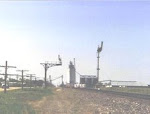 Santa Fe M-119
Santa Fe M-119A few months ago I posted a picture of an old Santa Fe doodlebug on display in the Travel Town museum in Los Angeles. It was a long shot, not very clear and it was copyrighted -- Ahhh! -- so once I realized that it had to come off. Unfortunately de-posting the photo also de-posted the post itself. Still, I wanted to leave a post that had the sense of what 'Little Ranger' was.
So here is a better snapshot of a Santa Fe motorcar, which as you can see, also has a 'trailer' car attached behind it for added capacity. Doodlebugs were usually one-car affairs with a cab for the engineer, fireman and brakemen; a compartment for baggage and light freight; and the rear half of the conveyance was a passenger compartment. A Doodlebug could pull a trailer for seating additional passengers when needed, and two or three freight cars for mixed-train work mostly on the branch lines.
This was the train that called at my hometown of El Dorado, Kansas; the postwar 'Little Ranger,' trains 25 and 26, which linked Eldorado (that's the railroad spelling with no space and lower case 'd') and Augusta with the Emporia and Winfield terminals where the real Ranger--Santa Fe's mainline train between Chicago and Houston--made daily stops.
The Little Ranger rolled in the daylight, both north- and southbound, meandering from Emporia to Ellinor, Bazaar, Matfield Green, Chelsea, Eldorado, Vanora, Augusta, Douglass, Rock, and finally Winfield where folks could catch the southbound Ranger. Through this pastoral Flint Hills countryside she carried the mail, milk, Railway Express, newspapers, and the citizens of Chase and Butler counties off to Chicago and the East, or maybe Texas or California. Back then, trips like that were big events in the lives of ordinary people. Very few could afford air travel and it was much less prolific. In a place like El Dorado the arrival or departure of the Little Ranger often was an occasion for someone. The depot, a 1903 brick county-seat-plan similar to Iola's or the one still standing in Garden City, was a little beehive of activity for a few moments until the train scooted on down the track which lay square in the middle of Gordy Street.
 Santa Fe M-177
Santa Fe M-177The Missouri Pacific also operated a passenger train from Wichita, through El Dorado, Eureka, Yates Center, Osawatomie and into Kansas City. The Sunflower, as it was known, didn't hold the quite as fast in my heart as the Little Ranger. Santa Fe's trains were really the best in America, capturing both eye and imagination. The classic steam power they used was just ending and the beautiful red, yellow and silver passenger locomotives were famous everywhere, as were the names Chief, Super Chief and Grand Canyon Limited. Little Ranger didn't connect with them but they all rolled under the same upper-quadrant semaphore signals up on the main line. It was a pedigree thing.
Both trains lasted until 1959. After that boarding trains was done in Newton or Wichita. Santa Fe razed the old depot in 1961. The private car tracks behind it were pulled up and it was paved over for parking. The MoPac depot survives today, magnificently restored and used as a community building of some sort. MoPac, like Santa Fe, Burlington and Union Pacific, took great pride in their station buildings which were the faces of those companies to the burghers.
With two refineries, an asphalt plant and the agriculture trade, Santa Fe and MoPac carried on at El Dorado with freight commerce. Alas, today the U.P. runs only one or two short trains a week on the old MoPac line between Wichita and El Dorado. East of there, the tracks have been gone for years. The old Santa Fe track on Gordy Street, the original 1872 branch from the main line at Florence, has been paved over. Santa Fe operates its busy transcontinental freight line around the east side of the city which joins the old line to Winfield just south of town.
Life goes on. But just for those of us from 'Eldorado' and Kansas who lived by train whistles, and waited at crossings as the trains that settled and built this part of the country rolled by, I pray the Little Ranger and her kind not be forgotten.








Very interesting article. My great grampa was a conductor for Southern Pacific and has bio wriiten on him. His son, my grampa had an old car that I also have on my blog site. Long live railroading! And, cleverly written blogs!
ReplyDeleteThank you!
ReplyDelete